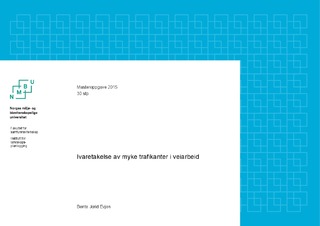Ivaretakelse av myke trafikanter i veiarbeid
Master thesis
Permanent lenke
http://hdl.handle.net/11250/293742Utgivelsesdato
2015-07-28Metadata
Vis full innførselSamlinger
- Master's theses (ILP) [763]
Sammendrag
Det blir stadig større fokus på de positive effektene av at flere går
eller sykler, og mange fortau og gang- og sykkelveier blir oppgradert
til å være universelt utformet. Likevel har ikke hensynet til myke
trafikanter og universell utforming blitt særlig innarbeidet i
håndbøkene i Statens vegvesen, som legger føringene for hvordan
selve byggefasen av prosjektene skal foregå. Denne oppgaven søker
å finne svar på hvordan myke trafikanter blir ivaretatt i veiarbeid, og
hvordan tilrettelegge for flest mulig. Det benyttes tre veiarbeid i
Trondheim kommune som case.
Basert på analyser gjennomført i forbindelse med casene, har jeg
kunnet sett på hvordan føringer og anbefalinger fra håndbøkene og
annen litteratur blir brukt til å tilrettelegge for myke trafikanter i dag.
Funnene ble at de myke trafikantene blir tenkt på i planleggingsfasen
og gjennomføringsfasen, men ikke i tilstrekkelig grad. Dette fører til
at løsningene ikke alltid blir så gode, spesielt i situasjoner der det
skjer mye forandringer. Jeg fant i tillegg ut at universell utforming
for myke trafikanter i veiarbeid ble lite vurdert, både i planleggingsog
gjennomføringsfasen.
Jeg har jobbet med konkrete løsningsforslag til hvordan man i
fremtiden kan tilrettelegge for flest mulig i veiarbeid. For å komme
frem til løsningsforslagene har jeg benyttet meg av data fra
analysene, og knyttet dette til teori om universell utforming. Jeg
foreslår at man i veiarbeid bør gjennomføre en tilgjengelighetsanalyse
når veisystemet for myke trafikanter skal endres. Dette for å
identifisere problemene, for så å kunne sette inn tiltak. Ofte er det
ikke avanserte tiltak som trengs. Jeg kommer også med eksempler på
tiltak og løsninger som kan bli brukt. Dette presenterer jeg ved bruk
av ulike bilder, foto og konseptskisser.
There is a increasing focus on the positive effects of that people are
walking or bicycling, and many sidewalks and walk-and bikeways
are being upgraded to be universally designed. Yet no consideration
for pedestrians and universal design has been incorporated in
manuals of Statens Vegvesen, which states the guidelines for how
the actual construction phase of the projects will take place. This
thesis seeks to find answers to how vulnerable road users are
safeguarded in roadworks, and how to facilitate as many as possible.
Three roadworks in Trondheim municipality are used as case
studies.
Based on analyzes carried out in connection with the cases, I have
been able to see how guidelines and recommendations of manuals
and other literature are being used to facilitate vulnerable road users
today. The findings were that the pedestrians are thought about in
both the planning and implementation phase, but not sufficiently.
This causes that the solutions are not that good, especially in
situations where there is a lot of changes. I found in addition that
universal design for pedestrians in road works were little considered,
both in the planning and implementation phases.
I have worked with concrete solutions for how to facilitate for as
many as possible in roadworks. To get to this solutions, I have taken
advantage of data from analyzes, and linked them to the theory of
universal design. I suggest that in roadworks they should conduct an
accessibility analysis when the road system for vulnerable road users
are to be changed. This to identify problems, and then being able to
put them into action. Often it's not advanced measures needed. I also
come with examples of measures and solutions that can be used.
This I present using different pictures, photography and concept
sketches.
